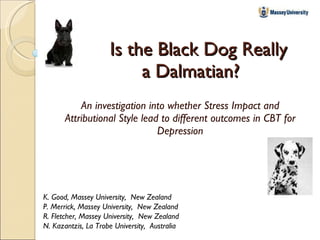
Is the black dog really a dalmatian, Kimberly Good
- 1. Is the Black Dog Really a Dalmatian? An investigation into whether Stress Impact and Attributional Style lead to different outcomes in CBT for Depression K. Good, Massey University, New Zealand P. Merrick, Massey University, New Zealand R. Fletcher, Massey University, New Zealand N. Kazantzis, La Trobe University, Australia
- 3. To get you thinking....
- 13. Average patient had a significant change in depressive symptoms Time explains 55% of within-patient variance Parameter Model A Model B Model C Model D Fixed Effects Initial status, Intercept γ 00 18.73*** 24.92*** π 0 i (1.82) (2.15) Stress Curve γ 01 - - - - Attributional Style γ 02 - - - - Rate of Change, π 1 i Intercept γ 1 0 - -0.93*** - (0.10) Stress Curve γ 11 - - - - Attributional Style γ 12 - - - - Variance Components Level 1 Within-person σ 2 e 61.82*** 27.72***** (3.91) (1.80) Level 2 In initial status σ 2 0 83.11*** 116.41*** (23.89) (33.25) In rate of change σ 2 1 - 0.29* - (0.12) Covariance σ e - -4.65* - (1.86) Pseudo R 2 statistics and Goodness of Fit R 2 e - 55% R 2 0 - - R 2 1 - - Deviance 3,748.63 3,391.92 AIC 3,754.63 3,403.92 BIC 3,767.42 3,429.51
- 14. Patients with different stress curves do not have significantly different intake BDIs or rates of change Introducing only stress as a predictor doesn’t explain a significant amount of variance in the model Parameter Model A Model B Model C Model D Fixed Effects Initial status, Intercept γ oo 18.73*** 24.92*** 26.29*** π 0 i (1.82) (2.15) (4.30) Stress Curve Le γ 01 - - -1.21 - - (3.24) Attributional Style Γ 02 - - - - - - Rate of Change, π 1 i Intercept γ 10 - -0.93*** -.051** - (0.10) (0.18) Stress Curve γ 11 - - -0.36* - - (0.14) Attributional Style γ 12 - - - - - - Variance Components Level 1 Within-person σ 2 e 61.82*** 27.72***** 27.70*** (3.91) (1.80) (1.80) Level 2 In initial status σ 2 0 83.11*** 116.41*** 115.48*** (23.89) (33.25) (32.99) In rate of change σ 2 1 - 0.29* 0.16* - (0.12) (0.06) Covariance σ e - -4.65* -2.63* - (1.86) (1.13) Pseudo R 2 statistics and Goodness of Fit R 2 e - 55% 55% R 2 0 - - 1% R 2 1 - - 45% Deviance 3,748.63 3,391.92 3,381.98 AIC 3,754.63 3,403.92 3,397.98 BIC 3,767.42 3,429.51 3,342.10
- 15. After controlling for attributional style, the difference in BDI rate of change for patients with different stress curves is significantly reduced Taken together, stress and attributional style explain 45% of variability in BDI initial status and 55% of variability in BDI rate of change Parameter Model A Model B Model C Model D Fixed Effects Initial status, Intercept γ oo 18.73*** 24.92*** 26.29*** 24.47*** Π 0 i (1.82) (2.15) (4.30) (3.65) Stress Curve γ 01 - - -1.21 -4.75 - - (3.24) (3.87) Attributional Style γ 02 - - - 12.79** - - - (3.87) Rate of Change, Π 1 i Intercept γ 10 - -0.93*** -.051** -0.45* - (0.10) (0.18) (0.17) Stress Curve γ 11 - - -0.36* -0.26 - - (0.14) (0.14) Attributional Style γ 12 - - - -0.37 - - - (0.18) Variance Components Level 1 Within-person σ 2 e 61.82*** 27.72***** 27.70*** 27.70*** (3.91) (1.80) (1.80) (1.80) Level 2 In initial status σ 2 0 83.11*** 116.41*** 115.48*** 80.23*** (23.89) (33.25) (32.99) (23.25) In rate of change σ 2 1 - 0.29* 0.16* 0.13 - (0.12) (0.06) (0.05) Covariance σ e - -4.65* -2.63* -1.61 - (1.86) (1.13) (0.85) Pseudo R 2 statistics and Goodness of Fit R 2 e - 55% 55% 55% R 2 0 - - 1% 31% R 2 1 - - 45% 55% Deviance 3,748.63 3,391.92 3,381.98 3,372.75 AIC 3,754.63 3,403.92 3,397.98 3,392.75 BIC 3,767.42 3,429.51 3,342.10 3,435.41
- 16. Attributional Style moderates the Stress-BDI relationship Rapid Minimal Expected Rapid BDI-II Improvement Stress Improvement Expected Minimal A depressognic attributional style slows the improvement in BDI-II caused by an improvement in stress Non-depressogenic Depressogenic
- 21. Selected References Abramson, L. Y., Metalsky, G. I., & Alloy, L. B. (1989). Hopelessness depression: A theory-based subtype of depression. Psychological Review, 96 , 358-372. Abramson, L. Y., Seligman, M. E. P., & Teasdale, J. D. (1978). Learned Helplessness in Humans: Critique and Reformulation. Journal of Abnormal Psychology, 87 (1), 49-74. Beck, A. T. (1976). Cognitive therapy and the emotional disorders. New York: International Universities Press. Beck, J. (1995). Cognitive Therapy: Basics and Beyond. New York: Guilford Press. Beck, A. T., Rush, A., Shaw, B., & Emery, G. (1979). Cognitive therapy of depression. New York: The Guilford Press. Cohen, S., Kessler, R. C., & Underwood Gordon, L. (1997). Measuring Stress: A Guide for Health and Social Scientists . New York, USA: Oxford University Press.
- 22. Selected References Hammen, C. (2005). Stress and Depression. Annual Review of Clinical Psychology, 1 , 293-319. Hedeker, R., & Gibbons, R. D. (2006). Longitudinal Data Analysis . New Jersey, USA: John Wiley & Sons, Inc. Horowitz, M., Wilner, N., & Alvarez, W. (1979). Impact of Event Scale: A Measure of Subjective Stress. Psychosomatic Medicine, 41 (3), 209-218. Kaplan, H. B. (1996). Psychosocial Stress: Perspectives on Structure, Theory, Life-Course, and Methods. London: Academic Press, Inc. Lambert, M. J. (2004). Bergin And Garfield’s Handbook of Psychotherapy and Behavior Change . New York, USA: John Wiley & Sons, Inc. Singer, J., & Willett, J.B. (2003). Applied Longitudinal Analysis: Modeling Change and Event Occurrence. New York: Oxford University Press.
- 23. Thank you! Contact: Kimberly Good DClinPsych candidate Massey University (Auckland, New Zealand) Email: [email_address]
